现在进行时课件五年级
- 格式:ppt
- 大小:1.83 MB
- 文档页数:24
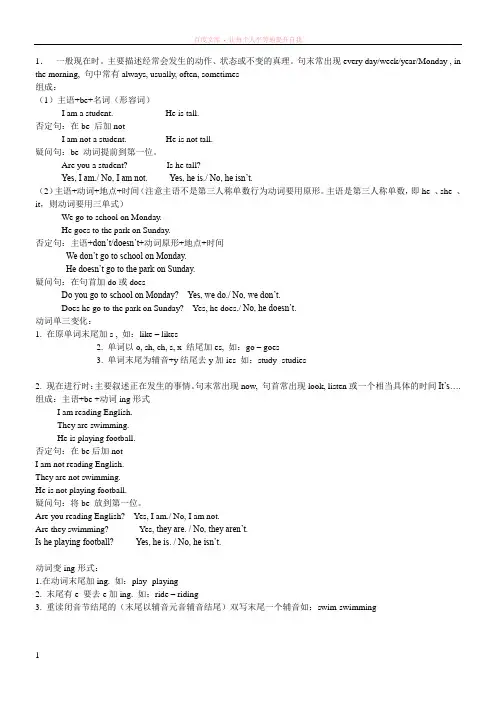
1.一般现在时。
主要描述经常会发生的动作、状态或不变的真理。
句末常出现every day/week/year/Monday , in the morning, 句中常有always, usually, often, sometimes组成:(1)主语+be+名词(形容词)I am a student. He is tall.否定句:在be 后加notI am not a student. He is not tall.疑问句:be 动词提前到第一位。
Are you a student? Is he tall?Yes, I am./ No, I am not. Yes, he is./ No, he isn’t.(2)主语+动词+地点+时间(注意主语不是第三人称单数行为动词要用原形。
主语是第三人称单数,即he 、she 、it,则动词要用三单式)We go to school on Monday.He goes to the park on Sunday.否定句:主语+don’t/doesn’t+动词原形+地点+时间We don’t go to school on Monday.He doesn’t go to the park on Sunday.疑问句:在句首加do或doesDo you go to school on Monday? Yes, we do./ No, we don’t.Does he go to the park on Sunday? Yes, he does./ No, he doesn’t.动词单三变化:1. 在原单词末尾加s , 如:like – likes2. 单词以o, sh, ch, s, x 结尾加es, 如:go – goes3. 单词末尾为辅音+y结尾去y加ies 如:study- studies2. 现在进行时:主要叙述正在发生的事情。
句末常出现now, 句首常出现look, listen或一个相当具体的时间It’s….组成:主语+be +动词ing形式I am reading English.They are swimming.He is playing football.否定句:在be后加notI am not reading English.They are not swimming.He is not playing football.疑问句:将be 放到第一位。
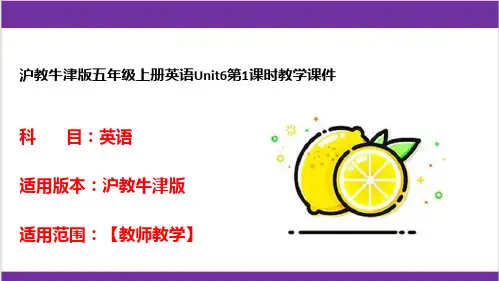
![人教PEP版英语五下《unit_4_what_are_you_doing》PPT课件之一[1]](https://uimg.taocdn.com/24c614f20242a8956bece4f2.webp)
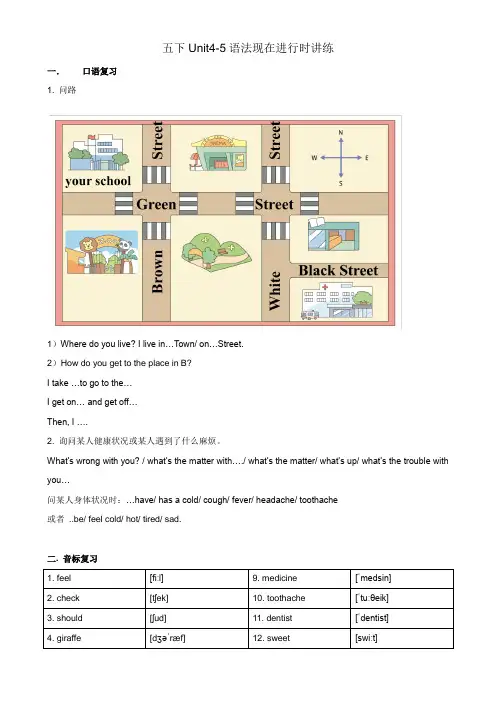
五下Unit4-5语法现在进行时讲练一.口语复习1. 问路1)Where do you live? I live in…Town/ on…Street.2)How do you get to the place in B?I take …to go to the…I get on… and get off…Then, I ….2. 询问某人健康状况或某人遇到了什么麻烦。
What’s wrong with you? / what’s the matter with…./ what’s the matter/ what’s up/ what’s the trouble with you…问某人身体状况时:…have/ has a cold/ cough/ fever/ headache/ toothache或者 ..be/ feel cold/ hot/ tired/ sad.二. 音标复习1. feel [fiːl]9. medicine [ˈmedsin]2. check [tʃek] 10. toothache [ˈtuːθeik]3. should [ʃud] 11. dentist [ˈdentist]4. giraffe [dʒəˈræf] 12. sweet [swiːt]5. point at [pɔɪnt] 13. pest [pest]6. neck [nek] 14. garden [ˈgɑrdn]7. sweep [swiːp]15. anything [ˈeniθiŋ]8. grow [grəu] 16. brush [brʌʃ][ch] chair; chicken; lunch; much; teach三. 介词复习1. 在…旁边_____________/ _____________2. 在…后面_____________3. _________ home; _________ school; _________ Park Station; __________ the traffic lights;4. _________one’s right’ left; _________ Sun Street;5. 沿着____________6. ___________Sunshine Town四. 语法讲解----现在进行时一.现在进行时的用法思考:如何辨别正在进行时?(1)用来表示说话时正在进行或者发生的动作,例如:Mother is cooking in t he kitchen.妈妈在厨房里煮饭。

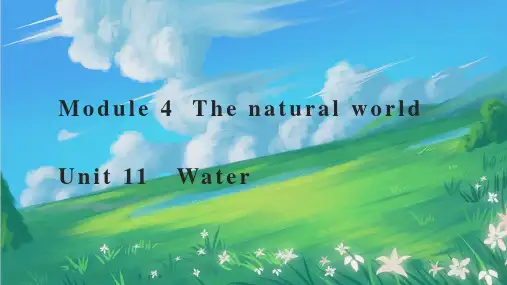
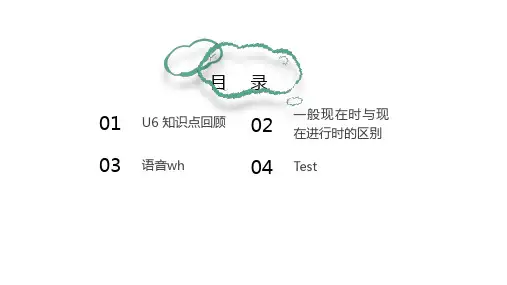
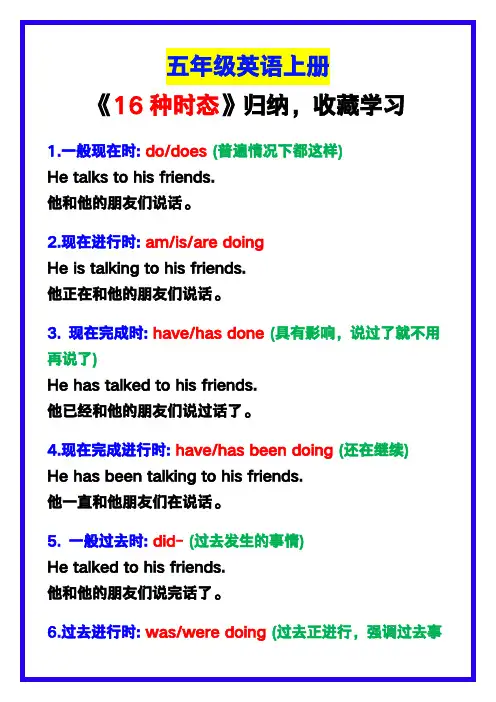
五年级英语上册《16种时态》归纳,收藏学习1.一般现在时: do/does(普遍情况下都这样)He talks to his friends.他和他的朋友们说话。
2.现在进行时: am/is/are doingHe is talking to his friends.他正在和他的朋友们说话。
3. 现在完成时: have/has done(具有影响,说过了就不用再说了)He has talked to his friends.他已经和他的朋友们说过话了。
4.现在完成进行时:have/has been doing (还在继续)He has been talking to his friends.他一直和他朋友们在说话。
5. 一般过去时: did-(过去发生的事情)He talked to his friends.他和他的朋友们说完话了。
6.过去进行时: was/were doing (过去正进行,强调过去事情的过程)He was talking to his friends.他过去正在和他的朋友们说话。
7. 过去完成时: had done(具有影响的、过去发生的)He had talked to his friends.他和他的朋友们那时已经说过话了。
8.过去完成进行时:had been doingHe had been talking to his friends.他那时一直和他朋友们在说话。
9.过去将来时: would doHe would talk to his friends.他那个时候将会和他的朋友们说话。
10.过去将来进行时: would be doingHe would be talking to his friends.他那个时候将会和他的朋友们一直聊。
11.过去将来完成时: would have done (却没有说)He would have talked to his friends.他那时本会和他朋友们说的。
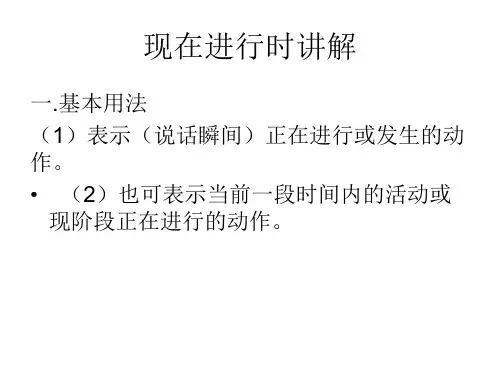

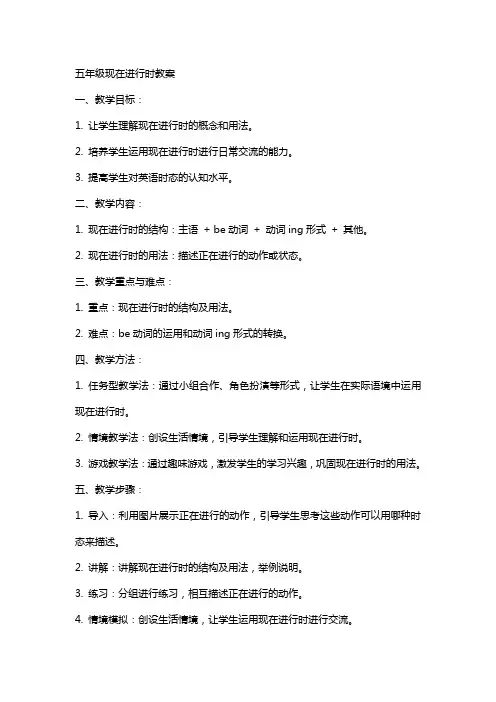
五年级现在进行时教案一、教学目标:1. 让学生理解现在进行时的概念和用法。
2. 培养学生运用现在进行时进行日常交流的能力。
3. 提高学生对英语时态的认知水平。
二、教学内容:1. 现在进行时的结构:主语+ be动词+ 动词ing形式+ 其他。
2. 现在进行时的用法:描述正在进行的动作或状态。
三、教学重点与难点:1. 重点:现在进行时的结构及用法。
2. 难点:be动词的运用和动词ing形式的转换。
四、教学方法:1. 任务型教学法:通过小组合作、角色扮演等形式,让学生在实际语境中运用现在进行时。
2. 情境教学法:创设生活情境,引导学生理解和运用现在进行时。
3. 游戏教学法:通过趣味游戏,激发学生的学习兴趣,巩固现在进行时的用法。
五、教学步骤:1. 导入:利用图片展示正在进行的动作,引导学生思考这些动作可以用哪种时态来描述。
2. 讲解:讲解现在进行时的结构及用法,举例说明。
3. 练习:分组进行练习,相互描述正在进行的动作。
4. 情境模拟:创设生活情境,让学生运用现在进行时进行交流。
5. 游戏:设计现在进行时游戏,巩固所学知识。
6. 总结:对本节课的内容进行总结,强调现在进行时的用法。
7. 作业:布置相关作业,让学生课后巩固现在进行时的运用。
8. 课后反思:根据学生课堂表现和作业完成情况,对教学进行总结和调整。
六、教学评价:1. 课堂参与度:观察学生在课堂上的参与情况,是否积极回答问题、参与讨论和活动。
2. 语言准确性:评估学生在运用现在进行时时语言的准确性,包括be动词的正确使用和动词ing形式的转换。
3. 交流能力:评估学生在小组合作和角色扮演中运用现在进行时进行交流的能力。
4. 作业完成情况:检查学生课后作业的完成质量,巩固现在进行时的理解和运用。
七、教学拓展:1. 对比过去进行时和现在进行时的用法,让学生理解两者之间的区别。
2. 引入其他时态的概念,如将来时、一般现在时等,为学生建立完整的时态概念体系。
现在进行时、一般将来时第1页共1页一、现在进行时,谓语由be+现在分词构成。
一般现在时现在进行时I run near my home every morning.I'm running near my home.They always play football in Sunday afternoon.They are playing football.She sometimes goes to library by bus.She is going to library by bus.二、一般将来时,谓语动词由①情态动词shall 、will+动词原形构成;②动词短语be going to+动词原形构成。
说明一说明二情态动词shall+动词原形主语是第一人称1、be going to 中的go 不是实义动词,是情态动词,不能翻译成“去”,只能翻译成“将”;2、与go 类似使用的动词还有come 、leave 、start 等,如be coming to 、be leaving to 也表达“即将”的意思;3、与shall 、will 相比,be going to 形式的一般将来时表达一种不久、很快即将发生的动作。
情态动词will+动词原形主语不是第一人称动词短语be going to+动词原形人称不限定示例:一般现在时一般将来时I run near my home every morning.I shall run near my home next minute.They always play football in Sunday afternoon.They will play football on Sunday afternoon.She sometimes goes to library by bus.She is going to go library by bus.说明:在现在进行时She is going to library by bus.中,going是实义动词“去”的意思,后接名词。
现在进行时&一般现在时(五上)英语时态:就是用动词的形式变化来表示不同时间内发生的动作或存在的状态现在进行时态一.概念:用来表示正在进行或发生的动作二.结构:主语+ be(am, is ,are)+ 动词现在分词+ 其他例如:I am reading English. 我正在读英语。
She is dancing. 她正在跳舞。
三.标志词:look(看)、listen(听)、now(现在)等例如:(1)Look, she is drawing a picture.看,他们正在画一幅画。
(2)Listen, she is singing now.听,她正在唱歌。
根据句意或场景来判断Be quiet, please. Mom is sleeping.(注释:妈妈正在睡觉才会提醒听者安静点)四.否定句:主语+ be(am, is, are)+ not +现在分词+其他例如:(1) I am not reading English. 我不在读英语。
(2) She is not dancing. 她没在跳舞。
五.一般疑问句:Be(Am, Is, Are) + 主语+ 现在分词+其他(将肯定句中的Be动词提前)例:—Are you reading English? 你正在读英语吗?—Yes, I am. 是的,我是在读英语。
—No, I’m not. 不,我没在读英语。
六.特殊疑问句:结构:特殊疑问词+ 一般疑问句例:- What are you doing? 你正在做什么?-I’m reading English. 我正在读英语。
七.现在分词的变化规则1.一般情况下,直接在动词后面加ing,如:read __ reading cook __ cooking2.以不发音字母e结尾,则去掉e,再加ing如dance ___ dancing take ___ taking3.如果动词只有一个元音字母,且末尾只有一个辅音字母时,双写词尾,再加ing如:put ___ putting run__ running sit ___ sittingget ___ getting stop ___ stopping一般现在时一.概念:通常表示经常发生的动作或存在的状态。